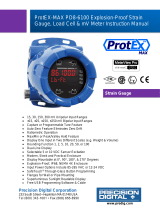
N1500LC Digital Panel Meter
NOVUS AUTOMATION 3/8
PKOLD – MAXIMUM VALUE
The digital panel meter will automatically work in the Peak Hold
mode whenever the key or the digital input are programmed as
PkoLd.
This operation mode makes that the digital panel meter always
shows the maximum value measured, since the last time the
key or the Digital Input were pressed.
Each activation of the key or digital input triggers a new Peak
Hold cycle, resetting the reading of the display to the current value of
the measure.
RST − CLEARS MAXIMUM AND MINIMUM
If configured with rSt, each activation of the key or digital input
clear the memory for a new cycle of maximum and minimum values.
KOLD – FREEZE MEASURED VALUE
The Hold function freezes the measured value showed in the
display. Each time the key or the Digital Input is selected, there
is a change from Hold to normal mode.
Whenever the digital panel meter is in the Hold mode, the message
koLd will be displayed so that the operator will be aware that the
value displayed is the frozen value and not the current reading.
TARE – TARE FUNCTION
It is available only in the digital input configuration or through the
key.
It changes indication to zero (0000.0), regardless of the value applied
to the input. It is used to eliminate indications of defined values. To
eliminate the tare, you must press the key.
AND KEYS
The same Tare function available for the Digital Input can be quickly
applied by using the key, which does not need to be set up. The
key is used to eliminate the tare applied.
The digital panel meter accepts successive tares, provided that the
input signal (gross weight) does not exceed the end of scale.
PROCESS VARIABLE RETRANSMISSION
As an option, the digital panel meter can be supplied with an isolated
0-20 mA or 4-20 mA analog output for Process Variable (PV)
retransmission. Available at terminals 29 and 30 of the rear panel of
the device.
When this option is available, the retransmission is always enabled
and does not require any intervention.
The PV values that define the scale of the 0 mA / 4 mA to 20 mA
retransmission can be programmed in the high and low output
limits (0v.lol and 0v.kol) at the Configuration Cycle. These limits
can be defined freely, and you can make a retransmission with
increasing or decreasing behavior toward to the indicated value.
For a voltage output signal, an external shunt (calibrated resistor)
should be installed at the analog output terminals.
LOAD CELL POWER SUPPLY (AUXILIARY P. S.)
The digital panel meter provides a voltage power supply of 10 Vdc to
excite field transmitters with 50 mA current capacity.
Available at the back panel terminals 16 and 17.
CUSTOMIZED LINEARIZATION
The digital panel meter has five types of input for non-linear signals:
c.4-20, c.0-20, c.50, c.-20 and c.20
For using these signals, is necessary to adopt the Custom
Linearization option. This feature combines the input signal to 30
user-defined line segments; setting two points for each segment, a
start and end and the respective display values. Thus, the indication
will have a non-linear behavior set by the input signal.
The following figure shows an input signal associated with four-line
segments (a, b, c, and d), causing that the resulting indication can be
approximated to the ideal value (characteristic curve). The resulting
indication is as best as the best straight segments are chosen.
Figure 2 – Custom linearization for a nonlinear signal
Note: The non-linear input signal shall have increasing pattern.
CONFIGURATION PROTECTION
As a safety measure, parameter changes can be prevented through
a key combination performed at each level. With this protection, the
parameters are still displayed but cannot be changed.
To protect any level, just go to the level and press the and
keys simultaneously for 3 seconds.
To unlock the level, press the and keys for 3 seconds.
The display will flash briefly to confirm locking or unlocking
level.
Inside the controller, the PROT key complements the protection
function. In the OFF position, you can do and undo the protection of
cycles. In the ON position, you cannot make changes. If there are
protections cycles, these cannot be removed; if there is not, they
cannot be promoted.
INSTALLATION
The digital panel meter is designed to be panel mounted. Remove the
two plastic fixing clamps from the instrument, insert the device into the
panel cut-out and slide firmly the fixing clamps from the rear against the
panel.
INSTALLATION RECOMMENDATIONS
• The wires of the input signals must be installed separated from
the output wires and power. If possible, in grounded conduits.
• The power supply for the instruments must be provided from an
exclusive power source.
• In controlling and monitoring applications, possible
consequences of any system failure must be considered in
advance. The internal alarm relay does not warrant total
protection.
• Use of RC FILTERS (47 R and 100 nF, serial) are highly
recommended when driving solenoids, contactor coils or other
inductive loads.














